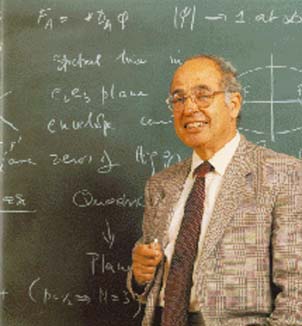


 تاريخ الرياضيات
تاريخ الرياضيات
 الرياضيات في الحضارات المختلفة
الرياضيات في الحضارات المختلفة 
 الرياضيات المتقطعة
الرياضيات المتقطعة
 الجبر
الجبر
 الهندسة
الهندسة 
 المعادلات التفاضلية و التكاملية
المعادلات التفاضلية و التكاملية 
 التحليل
التحليل
 علماء الرياضيات
علماء الرياضيات |
Read More
Date: 20-2-2018
Date: 25-2-2018
Date: 21-2-2018
|
Born: 22 April 1929 in London, England

Michael Atiyah's father was Lebanese and his mother was Scottish. His school education was partly in Cairo, at Victoria College, and partly in Manchester at Manchester Grammar School. After leaving school he did his military service, which was compulsory at the time, then entered Trinity College, Cambridge.
After graduating with his BA, Atiyah continued to undertake research at Cambridge obtaining his doctorate. He was then made a fellow of Trinity College, Cambridge in 1954. Atiyah spent the year 1955 as a Commonwealth Fellow at the Institute for Advanced Study in Princeton. Returning to Cambridge, he was a college lecturer from 1957 and a Fellow of Pembroke College from 1958. He remained at Cambridge until 1961 when he moved to a readership at the University of Oxford where he became a Fellow of St Catherine's College.
Atiyah was soon to fill the highly prestigious Savilian Chair of Geometry at Oxford from 1963, holding this chair until 1969 when he was appointed professor of mathematics at the Institute for Advanced Study in Princeton. After three years in Princeton, Atiyah returned to England, becoming a Royal Society Research Professor at Oxford. He was also elected a Fellow of St Catherine's College, Oxford.
Oxford was to remain Atiyah's base until 1990 when he became Master of Trinity College, Cambridge and Director of the newly opened Isaac Newton Institute for Mathematical Sciences in Cambridge.
Atiyah showed how the study of vector bundles on spaces could be regarded as the study of cohomology theory, called K-theory. Grothendieck also contributed substantially to the development of K-theory. In [4] Atiyah's early mathematical work is described as follows:-
Michael Atiyah has contributed to a wide range of topics in mathematics centring around the interaction between geometry and analysis. His first major contribution (in collaboration with F Hirzebruch) was the development of a new and powerful technique in topology (K-theory) which led to the solution of many outstanding difficult problems. Subsequently (in collaboration with I M Singer) he established an important theorem dealing with the number of solutions of elliptic differential equations. This 'index theorem' had antecedents in algebraic geometry and led to important new links between differential geometry, topology and analysis. Combined with considerations of symmetry it led (jointly with Raoul Bott) to a new and refined 'fixed point theorem' with wide applicability.
For these early achievements Atiyah was awarded a Fields Medal at the International Congress at Moscow in 1966. An address concerning Atiyah's contributions was given at the Congress by Henri Cartan, see [5]. The K-theory and the index theorem are studied in Atiyah's book K-theory (1967, reprinted 1989) and his joint work with G B Segal The Index of Elliptic Operators I-V in the Annals of Mathematics, volumes 88 and 93 (1968, 1971). Atiyah also described his work on the index theorem in The index of elliptic operators given as an American Mathematical Society Colloquium Lecture in 1973.
The ideas which led to Atiyah being awarded a Fields Medal were later seen to be relevant to gauge theories of elementary particles. Again we quote [4]:-
The index theorem could be interpreted in terms of quantum theory and has proved a useful tool for theoretical physicists. Beyond these linear problems, gauge theories involved deep and interesting nonlinear differential equations. In particular, the Yang-Mills equations have turned out to be particularly fruitful for mathematicians. Atiyah initiated much of the early work in this field and his student Simon Donaldson went on to make spectacular use of these ideas in 4-dimensional geometry. More recently Atiyah has been influential in stressing the role of topology in quantum field theory and in bringing the work of theoretical physicists, notably E Witten, to the attention of the mathematical community.
The theories of superspace and supergravity and the string theory of fundamental particles, which involves the theory of Riemann surfaces in novel and unexpected ways, were all areas of theoretical physics which developed using the ideas which Atiyah was introducing.
Atiyah has received many honours during his career, in addition to the Fields Medal referred to above, and it is impossible to list more than a few here. He was elected a Fellow of the Royal Society of London in 1962 at the age of 32. He received the Royal Medal of the Society in 1968 and its Copley Medal in 1988. He gave the Royal Society's Bakerian Lecture on Global geometry in 1975 and was President of the Royal Society from 1990 to 1995.
Among the prizes that he has received are the Feltrinelli Prize from the Accademia Nazionale dei Lincei in 1981, the King Faisal International Prize for Science in 1987, the Benjamin Franklin Medal and the Nehru Medal.
Atiyah was the American Mathematical Society Colloquium Lecturer in 1973. He was President of the London Mathematical Society in 1974-76 receiving its De Morgan Medal in 1980. Atiyah was knighted in 1983 and made a member of the Order of Merit in 1992. In 2004 he and Isadore Singer were awarded the Neils Abel prize of £480 000 for their work on the Atiyah-Singer Index Theorem.
He has been elected a foreign member of many national academies including those of the United States, Sweden, Germany, France, Ireland, India, Australia, China, Russia and the Ukraine. Many universities have awarded him an honorary degree including Bonn, Warwick, Durham, St Andrews, Dublin, Chicago, Edinburgh, Cambridge, Essex, London, Sussex, Ghent, Reading, Helsinki, Leicester, Rutgers, Salamanca, Montreal, Waterloo, Wales, Queen's-Kingston, Keele, Birmingham, Lebanon and the Open University.
Articles:



|
|
|
|
دراسة تحدد أفضل 4 وجبات صحية.. وأخطرها
|
|
|
|
|
|
|
جامعة الكفيل تحتفي بذكرى ولادة الإمام محمد الجواد (عليه السلام)
|
|
|